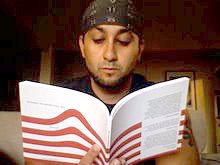
| Jacket 37 — Early 2009 | Jacket 37 Contents page | Jacket Homepage | Search Jacket |
The Internet address of this page is http://jacketmagazine.com/37/r-waldrop-rb-perez.shtml
Keith Waldrop
The Real Subject: Queries and Conjectures of Jacob Delafon with Sample Poems
reviewed by
C.S. Perez
67 pp. Omnidawn Publishing, 2004. US $14.95. ISBN: 1-890650-15-3 paper.
This review is about 2 printed pages long.
It is copyright © C.S. Perez and Jacket magazine 2009.
See our [»»] copyright notice.
1
In 1889, Emile Jacob and Maurice Delafon created Etablissements Jacob et Delafon (later known as Jacob Delafon), a French company that first specialized in sanitary fixtures and later provided full-line plumbing manufacturing. In The Real Subject: Queries and Conjectures of Jacob Delafon with Sample Poems, Keith Waldrop creates a profoundly humorous, and humorously profound, collection.
Section 2
Jacob Delafon becomes the fixture through which Waldrop collects zen-like aphorisms, philosophical and literary musings, strange factoids, and quirky observations. A majority of the text focuses on Delafon’s readings:
3
Jacob Delafon reads: “To treat a fever, cut a cockchafer in two. Tape half of it to your right arm and the other half to your left.”
He wonders about this.
What, actually, is a “cockchafer”?—he finds it a disturbing term.
He looks it up. It is a “pale-brown nocturnal beetle flying with a loud whirring sound.”
All this is theoretical. Jacob has no fever. (1)
4
Delafon may not have a fever, but his state oscillates between two opposing vectors: “the centrifugal push of paranoia and the centripetal pull of hysteria” (1). Waldrop captures both vectors with equal absurdity: “Jacob Delafon locates the word orthoepy, meaning the ‘correct pronunciation of words.’ The word seems to him unpronounceable” (2).
5
Formally, the book is built mainly upon prose fragments of varying lengths, which individually feel like character sketches and notes. Taken together, they form a haunting dream of a character: “Jacob Delafon has a nightmare which breaks into fragments, each fragment a nightmare on its own, like a worm cut in pieces, each segment still active, wriggling through his troubled sleep” (6). In another seemingly meta-poetic moment, we read:
6
Jacob Delafon reads that, when painting the portrait of a living creature, it helps to sketch the bones.
He cannot bring himself to start [… ] so likely it seems to him that he will never be up to adding vein or sinew, much less clothing the body with flesh and with skin.
7
Waldrop’s portrait of Jacob Delafon follows this method as we witness an author’s attempt to sketch the bones of his characters, uncertain whether or not this portrait will ever fully materialize. The hysteria of creation, coupled with the paranoia of death, establishes an undertow of dread and mania: “Jacob hates daylight-savings time. He thinks daylight should be squandered” (20).
8
Despite this dark humor, there are many moments where the punch-line delivers the reader into pure laughter: “Jacob Delafon likes to quote scripture. To a business man he knows, for instance, he cries, ‘Let thy companies deliver thee’” (39). And even more gut splitting: “Jacob Delafon cannot remember where he read the warning KEEP OUT OF REACH OF CHILDREN but he has done his best always” (40). And with irony: “Jacob Delafon finds an old manuscript, torn, covered with mildew. The text begins, ‘We see clearly… ” // The rest is illegible” (40). I haven’t read a poetry book that made me laugh out loud as much as The Real Subject. Nor have I read a collection that made me think so deeply: “Jacob Delafon notes that Stefan Themerson classified the expression ‘good God’ as an oxymoron. // Themerson, so far as Jacob remembers, never claimed there is no god, only that there is no god to speak of” (38).
9
Waldrop’s desire to speak of Delafon — through Delafon’s readings, memories, actions, and thoughts — is a search for “the real subject”:
10
Jacob Delafon reads of an Arabic poetic form called qasida—which, according to some ninth century writer, may be about almost anything, but ‘should begin with the evocation of lost dwelling places and lost love, continue with the description of a journey, and culminate in the real subject.’
In fact, the house where Jacob lives, and has lived for years, and where he will continue to live, he considers his lost home; Jane, in his arms, his lost love.
What he cannot seem to get to is a real subject (62).
11
Waldrop’s evocation of Delafon begins with the lost dwelling places of the mind and describes his journey to capture a personality through facets and fragments. Like Delafon, Waldrop never arrives at “the real subject”; instead, he argues that the journey itself — for us, the reading of the book, for Waldrop, the making of the book — is “the real subject.”

C.S. Perez
C.S. Perez is the co-founder of Achiote Press and author of from unincorporated territory [hacha] (Tinfish Press, 2008).